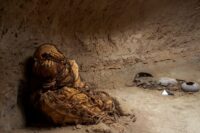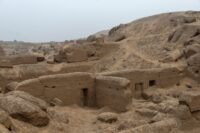 Archaeologists have discovered a pre-Incan mummy in excellent condition in the Cajamarquilla archaeological site about 15 miles inland from Lima, Peru. It is estimated to date to the Chaclla culture which developed in the high Andes around Lima between 1200 and 800 years ago.
Archaeologists have discovered a pre-Incan mummy in excellent condition in the Cajamarquilla archaeological site about 15 miles inland from Lima, Peru. It is estimated to date to the Chaclla culture which developed in the high Andes around Lima between 1200 and 800 years ago.
The mummy of what appears to be an adult male was found in an underground chamber tomb. The body was placed in fetal position and bound with ropes that kept the mummy in a tight crouch that it still retains today. It was buried with grave goods including pottery, stone tools and gourds containing organic remains.
“The main characteristic of the mummy is that the whole body was tied up by ropes and with the hands covering the face, which would be part of the local funeral pattern,” said [archaeologists Pieter] Van Dalen Luna, from the state university of San Marcos.
The remains are of a person who lived in the high Andean region of the country, he said. “Radiocarbon dating will give a more precise chronology.”
 Situated on the trade route linking the high Andes to the urban settlements on the coast, Cajamarquilla became a regionally important center of commerce in the Late Intermediate Period (1000 – 1470). Its prosperity was reflected in the sophistication of its adobe construction and complex city planning with large public buildings, boulevards and squares.
Situated on the trade route linking the high Andes to the urban settlements on the coast, Cajamarquilla became a regionally important center of commerce in the Late Intermediate Period (1000 – 1470). Its prosperity was reflected in the sophistication of its adobe construction and complex city planning with large public buildings, boulevards and squares.
The rope binding funerary practice is typically found among the late pre-Hispanic peoples of the high Andes. The mummy is therefore evidence that Cajamarquilla was inhabited not just by coastal peoples from the immediate area, but also by people of Andean origins. The exchange of trade likely resulted in a multi-ethnic population.